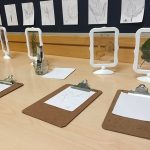This book has been on the top of my reading list for a few months now. Ever since I heard that Rebecca Bathurst-Hunt had a hand in contributing to this book I knew I had to take a look! I know Rebecca through a friend and we did a Personalized Learning Institute Program together in 2015. She is a Kindergarten teacher in Victoria who is extremely active on social media. I often scroll through her Twitter and Instagram accounts to get inspiration for my own classroom. She does everything from free inquiry, raising and releasing salmon, to mindfulness and meditation with five and six year olds!
Even though I have previous experience with inquiry, I found this book well laid out, straightforward, and is full of small things teachers can do in the classroom to develop a culture of wonder and inquiry. I did two of my practicums in IB schools as well as am a Level 1 trained IB teacher. I think this book is great for people that are anywhere on the spectrum of inquiry within their classrooms. I would love to introduce it to some of my colleagues as it provides a framework of how to set up authentic inquiry and some resources to support (spaces, places, technology, visible thinking strategies, etc.).
In this day in age, skills developed in an inquiry-based classroom are becoming more and more valuable. Skills such as questioning, critical and creative thinking, researching, and connecting to the community are what we are wanting to develop in children in order for them to be successful in their future.
Below are some ideas that I am going to try and integrate into my own practice and classroom this year!
- Posting a question grid or question/wonder prompts in order to give students a starting point
- Create a provocation space where students can interact with materials connected to our unit(s)
- Rolling cart with loose parts and materials in order to create a mobile Makerspace for the School
- With some inspirational books for students and teachers
- Also have a ring of cue cards with visuals and/or challenges for students using the different materials
- When planning my inquiry units – think more critically about how I can move from structured to free inquiry throughout the year (provide my students, especially the ones in grade three with more independent learning and researching skills)
- Post the visual of the different types of student inquiry on our inquiry board
- Using morning tubs for the first 20 minutes of the mornings instead of morning activity worksheets (give students the opportunity to create and communicate first thing in the morning and a good start to the day)
- Working with the Librarian to possibly create a Wonder Wall in the Library
- Can help support inquiry from the class but also can be a place where questions can guide what type of story or activity the librarian introduces to the students
- “The design of our library spaces impacts how our learners interact with one another as well as with the resources and experiences in the space….Add a provocation table, a poetry center, a Wonder Wall, and flexible furniture as well as visual cues, sentence stems, and supports to guide learners in how the spaces can be used…the Library should be the hub of student-led interests and passions in the school.” (pg. 118)
- Somehow combine classroom communication and social media (FreshGrade, Professional Blog, Instagram, Pinterest, Twitter, etc.)
I look forward to this upcoming school year and seeing how these ideas transform the learning community at my school!
I will ensure to update how it is going in the classroom this year! 🙂
Miss Miller







Recent Comments